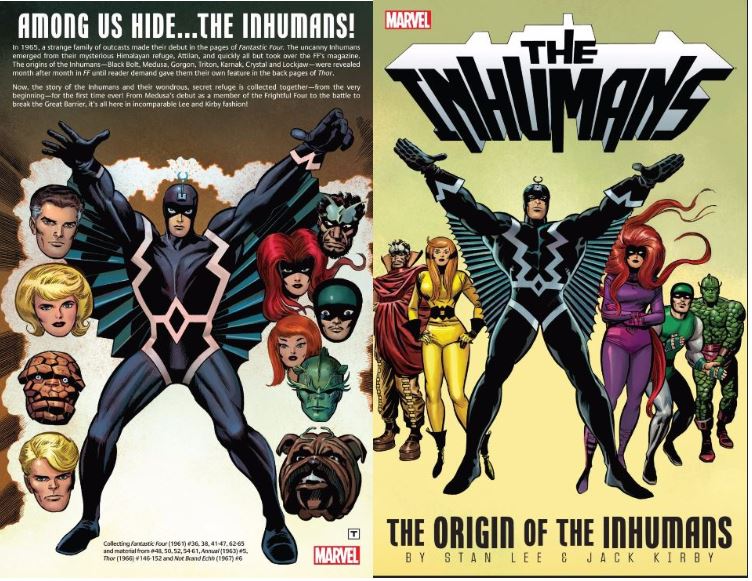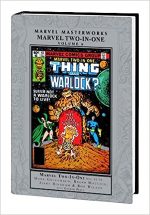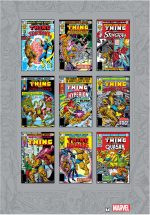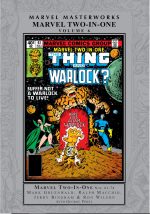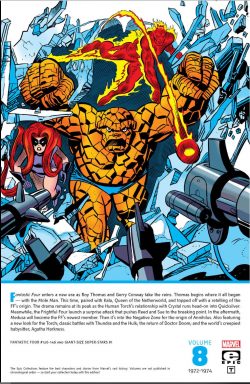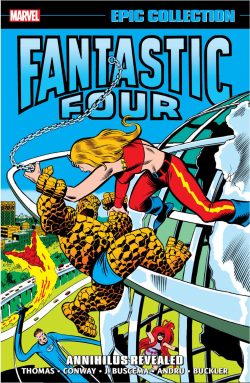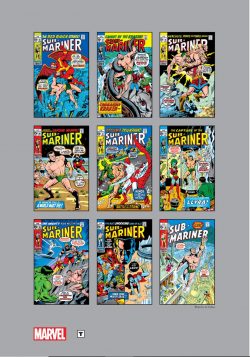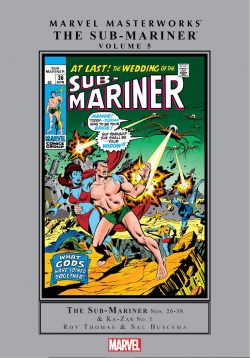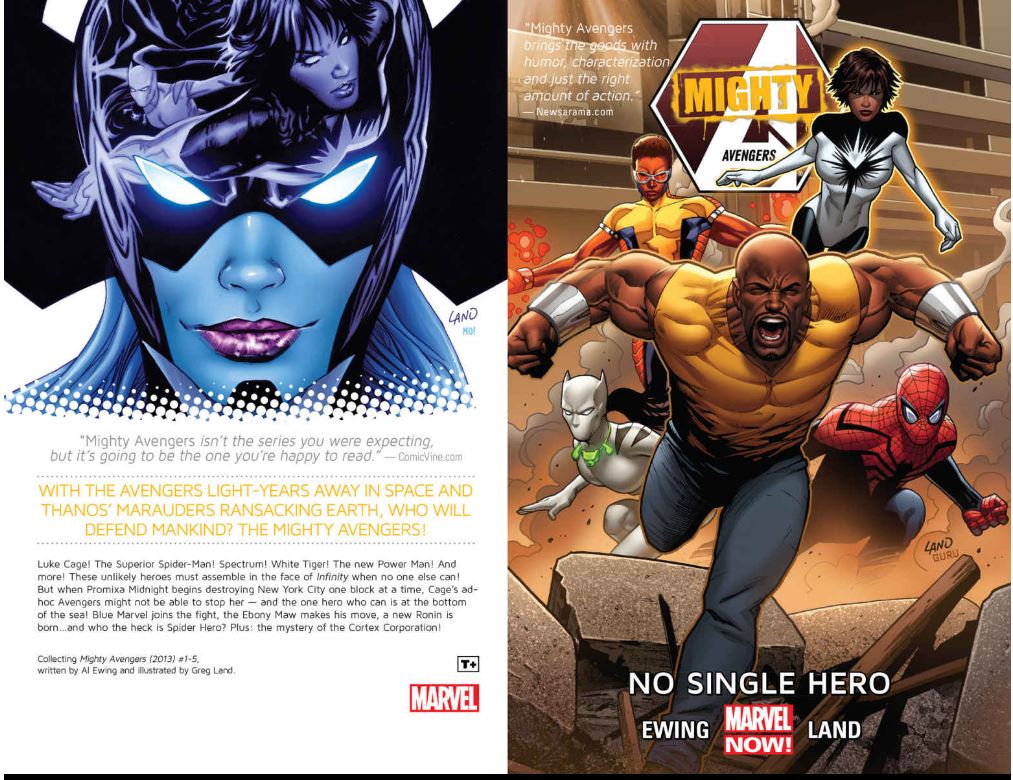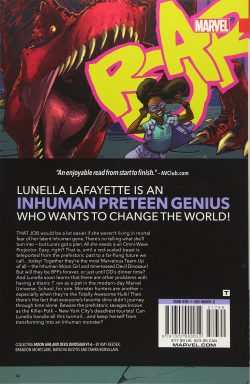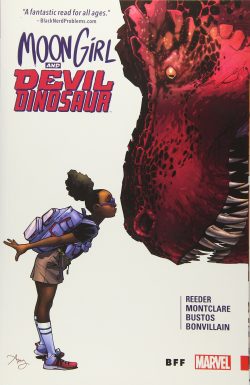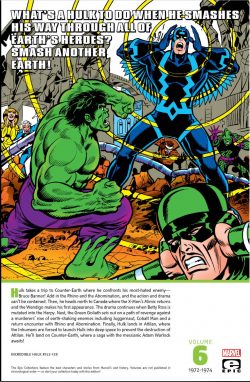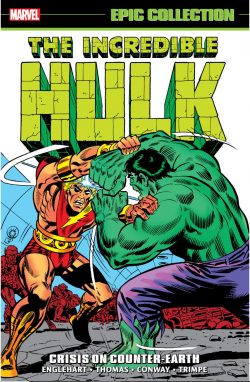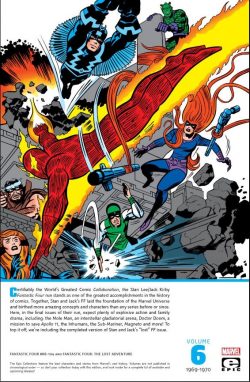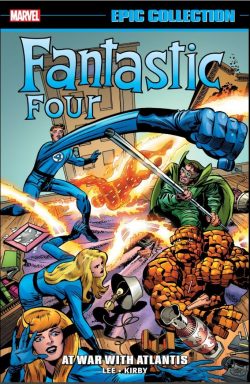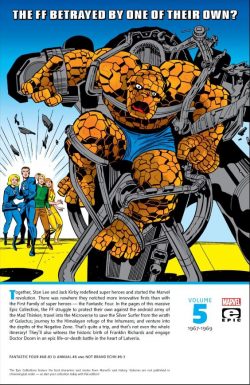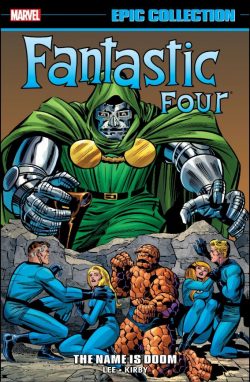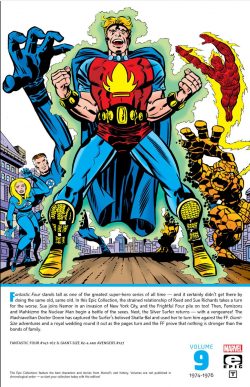
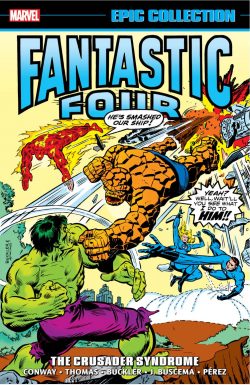
By Gerry Conway, Roy Thomas, Len Wein, Tony Isabella, Steve Englehart, Marv Wolfman, Chris Claremont, Rich Buckler, John Buscema, George Pérez, Sal Buscema, Bob Brown, Joe Sinnott, Jim Mooney, Joe Staton, Frank Giacoia, Mike Esposito, Chic Stone, Vince Colletta with Stan Lee, Dick Ayers, Paul Reinman & various (MARVEL)
ISBN 978-1-3029-4875-7 (TPB/Digital edition)
Monolithic modern Marvel truly began with the adventures of a small super-team who were as much squabbling family as coolly capable costumed champions. Everything the company is now stems from the quirky quartet and the groundbreaking, inspired efforts of Stan Lee & Jack Kirby…
Cautiously bi-monthly and cover-dated November 1961, Fantastic Four #1 – by Stan, Jack, George Klein & Christopher Rule – was raw and crude even by the ailing company’s standards: but it seethed with rough, passionate and uncontrolled excitement. Thrill-hungry kids pounced on its dynamic storytelling and caught a wave of change starting to build in America. It and succeeding issues changed comics forever. As seen in the premier issue, maverick scientist Reed Richards, his fiancée Sue Storm, their close friend Ben Grimm and Sue’s bratty teenaged brother Johnny survived an ill-starred private space-shot after Cosmic Rays penetrated their ship’s inadequate shielding.
All four permanently mutated: Richards’ body became elastic, Sue became (even more) invisible, Johnny Storm burst into living flame and tragic Ben shockingly devolved into a shambling, rocky freak. After the initial revulsion and trauma passed, they solemnly agreed to use their abilities to benefit mankind. Thus was born The Fantastic Four.
Throughout the 1960s it was indisputably the key title and most consistently groundbreaking series of Marvel’s ever-unfolding web of cosmic creation: a forge for new concepts and characters. Kirby was approaching his creative peak: continually unleashing his vast imagination on plot after spectacular plot, whilst Lee scripted some of the most passionate superhero sagas ever seen. Both were on an unstoppable roll, at the height of their powers and full of the confidence only success brings, with The King particularly eager to see how far the genre and the medium could be pushed… which is rather ironic since it was the company’s reticence to give the artist creative freedom which led to Kirby’s moving to National/DC in the 1970s.
Without Kirby’s soaring imagination the rollercoaster of mind-bending High Concepts gave way to more traditional tales of characters in conflict, with soap-opera leanings and super-villain-dominated Fights ‘n’ Tights dramas. This stripped-down, compelling compilation gathers Fantastic Four #147-167, Giant-Size Fantastic Four #2-4 and Avengers #127: collectively covering June 1974 to February 1976 and heralding a change of pace and partial return of The King – even if only on covers…
Fantastic Four #147 offers action-tinged melodrama with Gerry Conway, Rich Buckler & Joe Sinnott in how ‘The Sub-Mariner Strikes!’ as long-sidelined and neglected Susan Richards starts divorce proceedings against Reed whilst seemingly taking comfort in the arms of long-time admirer/stalker Prince Namor of Atlantis. When Reed, Johnny, Ben and Inhuman substitute teammate Medusa try to “rescue” her, the Atlantean ruler thrashes them before Sue sends them packing…
To add insult to injury, the dejected men return home to find the Baxter Building once more invaded by the Frightful Four and are forced to fight a ‘War on the Thirty-Sixth Floor!’ Sadly The Sandman, Wizard and Trapster have no idea their newest ally Thundra is secretly smitten with the Thing. FF #149 resolves the scandalous Sub-Mariner storyline as the undersea emperor invades New York in ‘To Love, Honour, and Destroy!’ Happily, his awesome attack is merely a cunning plan to trick Sue into reconciling with her husband. It almost works…
Courtesy of Conway, John Buscema & Chic Stone, Giant-Size Fantastic Four #2 reveals a time-twisting ‘Cataclysm!’, wherein cosmic voyeur The Watcher warns of a hapless innocent who has inadvertently altered history, thanks to Dr. Doom’s confiscated time platform. Once again the supposedly non-interventionist extraterrestrial expects the FF to fix a universal dilemma…
With more than one temporal hot-spot, Reed and Johnny head for Colonial America to rescue the Father of the Nation in ‘George Washington Almost Slept Here!’, whilst Ben and Medusa crash into the “Roaring Twenties” and save the time-lost wanderer from being rubbed out by racketeers in ‘The Great Grimmsby’. Thinking their mission accomplished, the heroes are astounded to then find themselves trapped in timeless Limbo, battling monstrous giant Tempus before escaping to their restored origin point in ‘Time Enough for Death!’
For months lovelorn Johnny had fretted and fumed that his first true love Crystal was to marry super-swift mutant Quicksilver. That plot-thread finally closed in a 2-part crossover tale opening in Avengers #127 (September 1974). Crafted by Steve Englehart, Sal Buscema & Joe Staton, ‘Bride and Doom!’ sees the Assemblers travel to Attilan (hidden homeland of the Inhumans) for the wedding of aforementioned speedster Pietro to elemental enchantress/Royal Princess, only to meet an uprising of the genetic slave-race designated Alpha Primitives. Once again, sinister robotic colossus Omega has incited revolt, but this time it isn’t insane usurper Maximus behind the seditious skulduggery but an old Avengers enemy who reveals himself in the concluding chapter from in Fantastic Four #150.
‘Ultron-7: He’ll Rule the World!’ (Conway, Buckler & Sinnott) finds both teams joining Black Bolt’s Inhumans against the malign A.I., but only saved by a veritable Deus ex Machina after which, at long last, ‘The Wedding of Crystal and Quicksilver’ finally closes events on a happy note – for everybody but the Torch, that is…
The dramatic tensions resume with Giant-Size Fantastic Four #3 as plotter Gerry Conway, scripter Marv Wolfman and illustrators Rich Buckler & Joe Sinnott deliver an epic tale of global import. The extra-special quarterly Giant-Size range was devoted to offering blockbuster thrills, and herein reveal ‘Where Lurks Death… Ride the Four Horsemen!’ as cosmic aliens arrive, intent on scourging the Earth.
Forewarned after the team stumble across the first horror in ‘…There Shall Come Pestilence’, our harried heroes split up with Inhuman stand-in Medusa and Johnny striving against international madness in ‘…And War Shall Take the Land!’ whilst Reed and Ben fight to foil the personification of Famine in ‘…And the Children Shall Hunger!’, before all reunite to wrap up the final foe in ‘…All in the Valley of Death!’
In FF #151 Conway, Buckler & Sinnott begin revealing the truth about the mysterious “Femizon” stalking the Thing. ‘Thundra and Lightning!’ introduces male-dominated alternate Future Earth Machus and its brutal despot Mahkizmo, the Nuclear Man, who explosively invades the Baxter Building in search of a mate to dominate and another world to conquer…
Inked by Jim Mooney, #152 exposes ‘A World of Madness Made!’ with the team captive in the testosterone-saturated side-dimension whilst Medusa seemingly flees, whilst actually seeking reinforcements from the diametrically-opposed Femizon future/alternity, resulting in two universes crashing together in the concluding ‘Worlds in Collision!’ by Tony Isabella, Buckler & Sinnott.
Rapidly reworked by Len Wein, Fantastic Four #154 featured ‘The Man in the Mystery Mask!’: a partial reprint from Strange Tales #127 in which Stan Lee, Dick Ayers & Paul Reinman pitted Ben and Johnny against ‘The Mystery Villain!’. Here, however, Bob Brown, Frank Giacoia & Mike Esposito’s revisions depict how Reed’s early lesson in leadership has been hijacked by another old friend with explosive and annoying results…
Meanwhile over in Giant-Size Fantastic Four #4, Wein, Chris Claremont, John Buscema, Chic Stone & Sinnott unite to introduce ‘Madrox the Multiple Man’: a young mutant who grew up on an isolated farm unaware of the incredible power he possessed. When his parents pass away, the kid is inexplicably drawn to New York City, where the hi-tech suit he wears to contain his condition malfunctions. Soon the boy devolves into a mobile fission device that can endlessly, lethally replicate himself. Thankfully the FF are aided by mutant Moses Charles Xavier who dutifully takes young Jamie under his wing…
A minor classic from Wein, Buckler & Sinnott follows s seen in Fantastic Four #155-157 when the long dormant Silver Surfer resurfaces in ‘Battle Royal!’ – apparently a murderous thrall of Doctor Doom. The Iron Dictator commands the Stellar Skyrider because he holds the alien’s lover Shalla Bal –-even cruelly threatening to take her in marriage. However, as seen in ‘Middle Game!’ (with Roy Thomas joining as co-writer and Editor) the Surfer cannot kill and merely delivers the defeated FF as prisoners to the Devil Doctor’s citadel. Naturally, there are schemes within schemes unfolding and Doom is playing a waiting game whilst covertly siphoning the Surfer’s “Power Cosmic” to fuel a deadly Doomsman mechanoid…
With Thomas in full authorial control ‘And Now… the Endgame Cometh!’ sees the heroes fight back to conquer the Lethal Latverian, blithely unaware the entire charade has been a crafty confection of malignly manipulative demon-lord Mephisto…
The furore is followed by another nostalgia-tinged 2-part epic beginning with FF #158’s ‘Invasion from the 5th (Count it, 5th!) Dimension’ by Thomas, Buckler & Sinnott. When one of the Torch’s earliest solo scourges returns to occupy the homeland of the Inhumans, extra-dimensional dictator Xemu opens his campaign of vengeance by dispatching Quicksilver to lure his sister-in-law Medusa back to Attilan. The intention is to force defiant King Black Bolt to utilise his doomsday sonic power on the invaders’ behalf, for which the conqueror needs the silent king’s true love as a bargaining chip. However, when the FF accompany her into the blatant trap, they bring a hidden ally who turns the tables on Xemu, unleashing ‘Havoc in the Hidden Land!’, coincidentally and at last reuniting the First Family of comic book fiction…
More pan-dimensional panic ensues when a multiversal conflict is cunningly concocted by a hidden mastermind orchestrating Armageddon for a trio of dimensionally-adjacent planets for ‘In One World… and Out the Other!’ Devised by Thomas, John Buscema & Stone, the initial chapter sees shapeshifting Reed Richards sell his patents to a vast corporation, even as in the streets his counterpart from another universe is kidnapped by barbarian warlord Arkon the Magnificent. That abduction is investigated by a very Grimm Thing who has uncomfortable suspicions about what’s occurring…
With Buckler & Sinnott doing the depicting ‘All the World Wars at Once!’ expands the saga as Johnny Storm visits the recently liberated 5th Dimensional Earth to discover it under assault by androids from yet another slightly different one. As the Thing teams up with his other-earth counterpart to quell a dinosaur invasion, “our” world is assaulted by an army from the 5th dimension led by the Torch. With each realm believing itself provoked by trans-terrestrial aggressors, the divided team only knows one thing: each invading force is using weaponry invented by Richards…
The crises peaks in ‘The Shape of Things to Come!’ as the mastermind is exposed and the scheme to annihilate three worlds come close to fruition, necessitating a voyage to a cosmic nexus point and a devastating battle with yet another twisted alternate-reality hero to save existence in a spectacular and poignant ‘Finale #163.
A new direction began with #164 (part 1 of a reconditioned yarn originally intended for Giant-Size Fantastic Four), courtesy of Thomas and then-neophyte illustrator George Pérez, backed up by Sinnott. ‘The Crusader Syndrome!’ sees the team battling a veteran superhero gone bad since his last outing as Atlas-Era champion Marvel Boy. Now as The Crusader he wages savage war on financial institutions whose self-serving inaction doomed his adopted Uranian race in the 1950s. However, his madness and savagery are no match for the FF and #165’s ‘The Light of Other Worlds!’ details his apparent demise. It also sparks many successful additions to Marvel Continuity, such as new hero Quasar, the 1950s Avengers and Agents of Atlas whilst introducing Galactus’ herald-in-waiting Frankie Raye as Johnny’s new girlfriend…
This formidable high-tension Fights ‘n’ Tights tome terminates in a titanic tussle as Vince Colletta inks #166 as ‘If It’s Tuesday, This Must be the Hulk!’ as the team hunts the Gamma Goliath with a potential cure for Bruce Banner. Sadly, aggressive and insulting military treatment of their target enrages fellow-monster Ben Grimm who unites with The Hulk to menace St. Louis, Missouri as ‘Titans Two!’ (with Sinnott back on inks). Following a mighty struggle with his old friends and constantly bathed in Hulk’s Gamma radiation, Ben is permanently reduced to human form and contemplates a whole new life…
To Be Continued…
With covers by Buckler, Gil Kane, John Romita, Ron Wilson, Kirby, Sinnott and more this power-packed package also includes the covers to all-reprint Giant-Sized Fantastic Four #5 & 6 and the original unused cover for GSFF #5 (which contents became FF #158-159); house ads and the new material from The Fabulous Fantastic Four Marvel Treasury Edition #2 (December 1975). This bombastic oversized tabloid edition featured a bevy of classic yarns and is represented here by front-&-back cover art from John Romita, a Marie Severin frontispiece and Stan Lee Introduction, contents page and double-page pin-up of the team and supporting cast by John Buscema & Giacoia.
Also on view are extracts from F.O.O.M. #8-10 (comedic exploits of Doctor Foom by Charley Parker), pertinent pages by Buckler & Sinnott from The Mighty Marvel Calendar 1975, cover plus splash page by Dave Cockrum & Sinnott from November 1977’s Marvel Super Action #4 which reprinted Marvel Boy stories from the early 1950s and a gallery of original art pages and a colour guide.
Although Kirby had taken the unmatched imagination and questing sense of wonder with him on his departure, the sheer range of beloved characters and concepts he had created with Lee carried the series for years afterwards. So once writers who shared their sensibilities were crafting the stories a mini-renaissance began. Although the “World’s Greatest Comics Magazine” didn’t quite return to the stratospheric heights of yore, this period offers fans a tantalising taste of the glory days. These honest and extremely capable efforts will still thrill and enthral the generous and forgiving casual browser looking for an undemanding slice of graphic narrative excitement.
© 2023 MARVEL.

